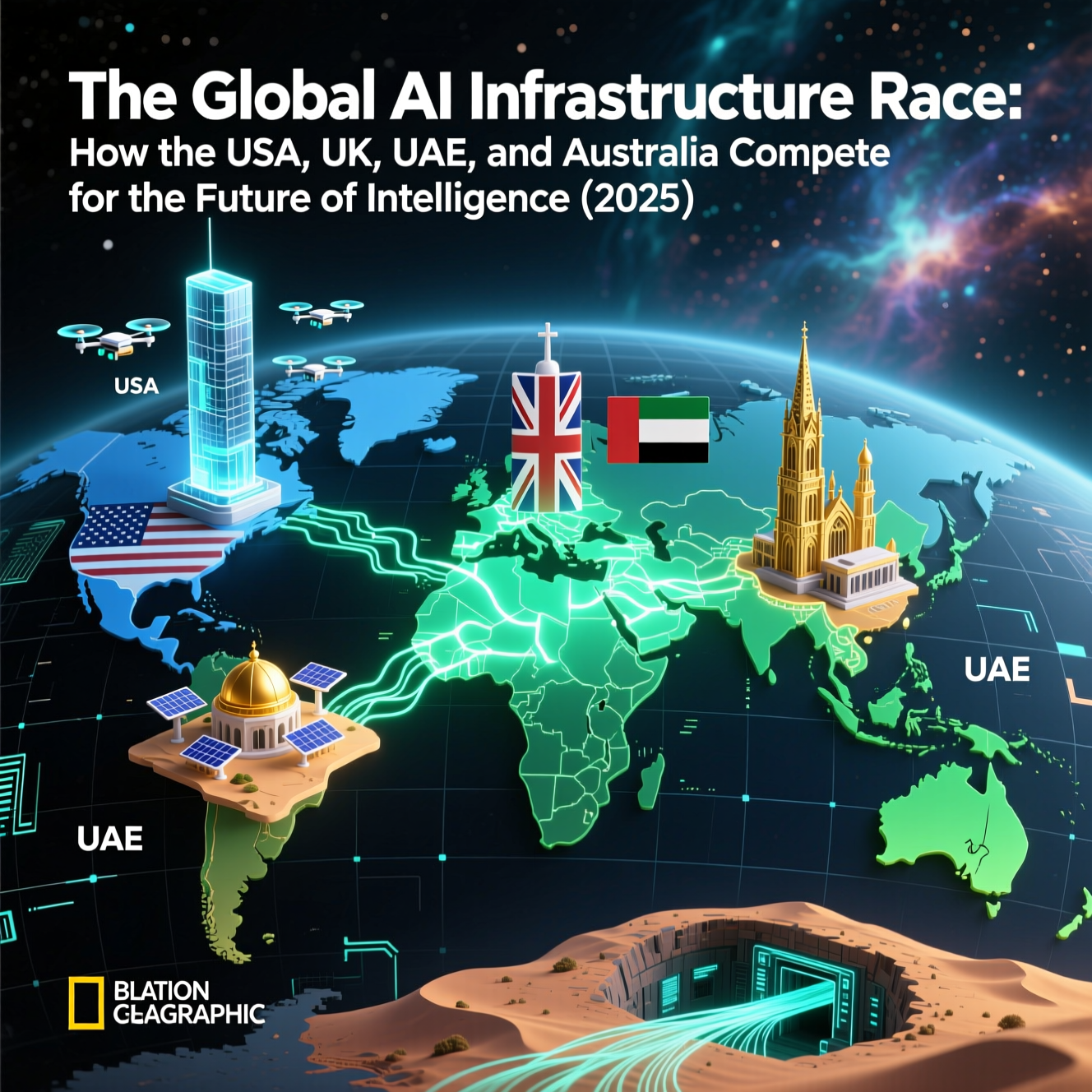Artificial Intelligence (AI) has moved from hype to infrastructure — from research labs to national policy. Across the USA, UK, UAE, and Australia, a silent but powerful race is unfolding: who will control the infrastructure that powers the world’s next generation of intelligent systems?
From semiconductor factories to cloud data centers, governments and tech giants are spending billions to ensure their countries aren’t left behind. This isn’t just about AI tools — it’s about digital power.
🇺🇸 United States: The AI Powerhouse Facing a Chip Crisis
The United States remains the epicenter of global AI innovation, with companies like OpenAI, NVIDIA, Google, and Microsoft leading the frontier. However, 2025 has introduced a new challenge: chip dependency.
⚙️ The Infrastructure Boom
The U.S. has accelerated efforts to build AI-ready data centers, investing over $100 billion in infrastructure this year alone. NVIDIA’s new “Blackwell” GPU architecture and Amazon’s AI-focused data centers are key to supporting national-scale models.
But energy consumption is becoming a concern. Data centers already account for 4% of U.S. electricity use, forcing tech companies to adopt renewable microgrids and liquid cooling systems.
🧠 The Policy Push
The Biden administration’s AI Executive Order enforces responsible model development, requiring transparency from AI developers. At the same time, it incentivizes domestic chip production under the CHIPS and Science Act, aiming to reduce reliance on Asia.
Key takeaway:
America leads in AI software and models, but chip supply remains its biggest vulnerability.
🇬🇧 United Kingdom: The Regulator’s Approach to AI Power
The UK has taken a unique path — instead of racing to build the biggest data centers, it’s focusing on ethical AI governance and AI safety.
🧩 Regulation Meets Innovation
In 2025, the UK Parliament warned that the country’s Online Safety Regime still struggles to handle misinformation from AI systems. To counter this, the AI Safety Institute in London is testing advanced models for bias, safety, and misinformation — an effort unmatched globally.
Meanwhile, British firms like DeepMind (Google-owned) and Graphcore continue to push innovation in AI hardware and neural processors, strengthening the UK’s technical credibility.
⚖️ Building “Trust Infrastructure”
Instead of purely hardware, the UK is investing in what experts call “trust infrastructure” — a framework ensuring AI systems are safe, transparent, and human-aligned.
Key takeaway:
The UK might not win the compute race, but it could win the trust race — which will matter just as much.
🇦🇪 United Arab Emirates: Building a Smart Nation from the Ground Up
The UAE isn’t waiting for the future — it’s constructing it. From smart policing to space technology, the country has made AI a core national strategy.
🚀 Government-Driven Innovation
In 2025, the UAE Space Agency launched a new digital licensing platform designed to streamline satellite and AI-related projects. At GITEX Global 2025, Dubai Police showcased next-gen AI-powered surveillance systems, smart traffic prediction, and digital twin city models.
These moves are part of the UAE’s National AI Strategy 2031, which aims to make it one of the world’s top AI hubs.
🏗️ Infrastructure and Education
Dubai’s Digital Economy Chamber announced partnerships with leading universities to train 50,000 new AI professionals by 2027. Meanwhile, the country is investing heavily in data centers and quantum-ready networks in partnership with global cloud leaders.
Key takeaway:
The UAE is proving that with the right policy and vision, even small nations can become global AI leaders.
🇦🇺 Australia: Balancing AI Growth with Sustainability
Australia is fast becoming the Asia-Pacific’s AI sustainability leader. As its mining, healthcare, and education sectors integrate AI, the nation is focusing on responsible and energy-efficient infrastructure.
🌱 Green AI Strategy
The Australian government launched the National AI and Robotics Framework 2025, emphasizing carbon-neutral innovation. Cloud providers like Canva Cloud, Google Cloud Sydney, and Microsoft Azure Australia East are expanding with solar-powered data centers.
💡 Enterprise Adoption
Companies in finance and logistics are adopting AI faster than ever before, but cost concerns remain. Analysts warn that AI operational costs in Australia are growing by 20% annually, pushing firms toward shared AI platforms and federated learning to cut expenses.
Key takeaway:
Australia’s advantage lies in sustainability — turning green innovation into an AI strength.
🌍 Global Comparison: Different Roads to the Same Destination
| Country | Core Strategy | Strength | Challenge |
|---|---|---|---|
| 🇺🇸 USA | Infrastructure & chip dominance | Scale & R&D | Chip supply chain |
| 🇬🇧 UK | Ethical AI & regulation | Governance leadership | Limited compute |
| 🇦🇪 UAE | National vision & innovation | Rapid transformation | Talent development |
| 🇦🇺 Australia | Sustainable AI | Green infrastructure | High costs |
Each nation reflects a different approach to the same problem — how to control the future of AI. While the U.S. leads in scale, the UAE leads in execution speed, the UK in ethics, and Australia in sustainability.
🔮 What’s Next: The Coming “AI Cold War”
Analysts predict that by 2026, global AI competition will mirror past geopolitical rivalries. Nations will seek not just AI dominance, but AI sovereignty — ensuring their citizens’ data, infrastructure, and innovation pipelines remain local.
This means:
- Data localization laws will tighten.
- AI regulation will standardize across borders.
- Talent wars between countries will intensify.
- AI energy consumption will become a political issue.
The race isn’t just about who builds the best models, but who builds the smartest ecosystem.
💬 Final Thoughts
The AI infrastructure race of 2025 shows a world at the crossroads of innovation and responsibility.
The USA wants dominance.
The UK wants safety.
The UAE wants transformation.
The Australia wants sustainability.
Together, they shape the blueprint of how nations — large or small — can define their digital destiny.
“The future of AI isn’t just about who builds it — it’s about who builds it responsibly.”
— TechPodda Editorial Team


